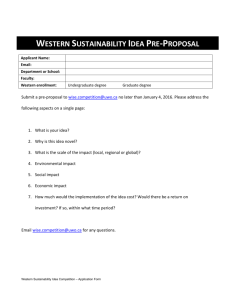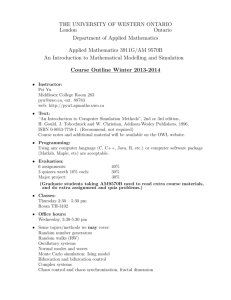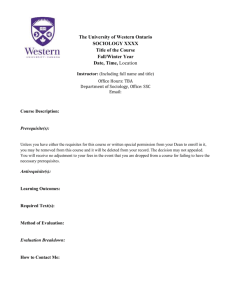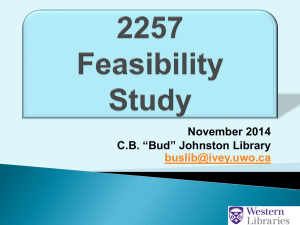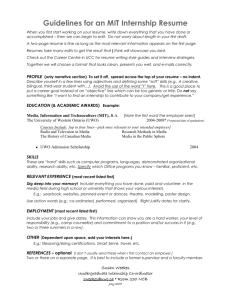The University of Western Ontario
advertisement
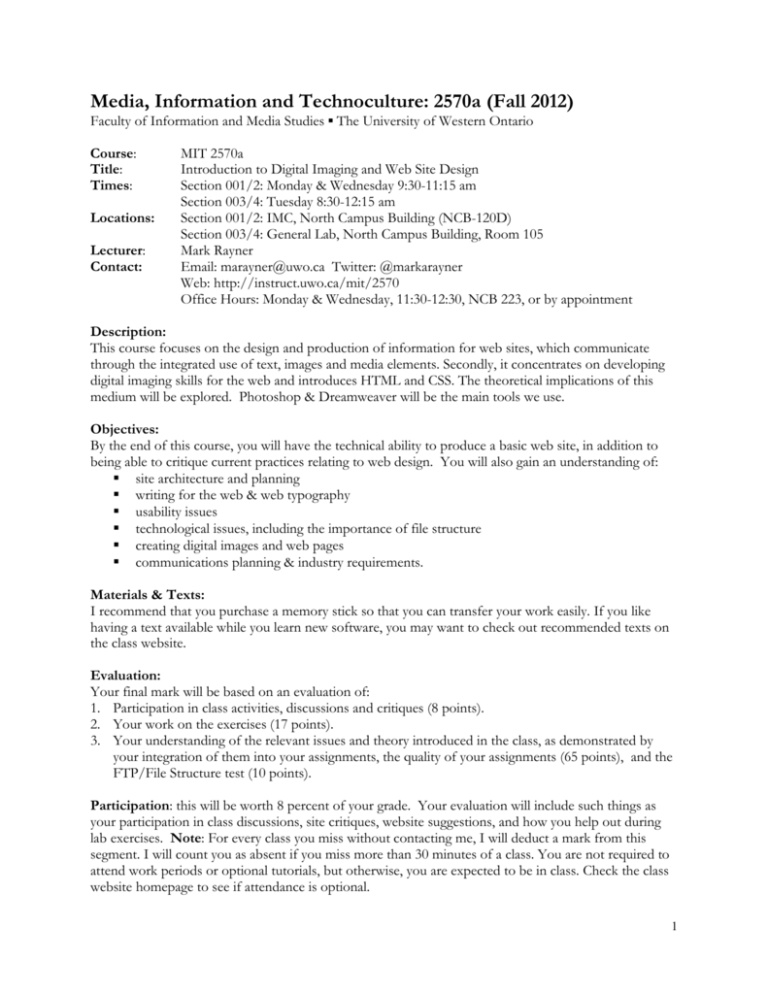
Media, Information and Technoculture: 2570a (Fall 2012) Faculty of Information and Media Studies ▪ The University of Western Ontario Course: Title: Times: Locations: Lecturer: Contact: MIT 2570a Introduction to Digital Imaging and Web Site Design Section 001/2: Monday & Wednesday 9:30-11:15 am Section 003/4: Tuesday 8:30-12:15 am Section 001/2: IMC, North Campus Building (NCB-120D) Section 003/4: General Lab, North Campus Building, Room 105 Mark Rayner Email: marayner@uwo.ca Twitter: @markarayner Web: http://instruct.uwo.ca/mit/2570 Office Hours: Monday & Wednesday, 11:30-12:30, NCB 223, or by appointment Description: This course focuses on the design and production of information for web sites, which communicate through the integrated use of text, images and media elements. Secondly, it concentrates on developing digital imaging skills for the web and introduces HTML and CSS. The theoretical implications of this medium will be explored. Photoshop & Dreamweaver will be the main tools we use. Objectives: By the end of this course, you will have the technical ability to produce a basic web site, in addition to being able to critique current practices relating to web design. You will also gain an understanding of: site architecture and planning writing for the web & web typography usability issues technological issues, including the importance of file structure creating digital images and web pages communications planning & industry requirements. Materials & Texts: I recommend that you purchase a memory stick so that you can transfer your work easily. If you like having a text available while you learn new software, you may want to check out recommended texts on the class website. Evaluation: Your final mark will be based on an evaluation of: 1. Participation in class activities, discussions and critiques (8 points). 2. Your work on the exercises (17 points). 3. Your understanding of the relevant issues and theory introduced in the class, as demonstrated by your integration of them into your assignments, the quality of your assignments (65 points), and the FTP/File Structure test (10 points). Participation: this will be worth 8 percent of your grade. Your evaluation will include such things as your participation in class discussions, site critiques, website suggestions, and how you help out during lab exercises. Note: For every class you miss without contacting me, I will deduct a mark from this segment. I will count you as absent if you miss more than 30 minutes of a class. You are not required to attend work periods or optional tutorials, but otherwise, you are expected to be in class. Check the class website homepage to see if attendance is optional. 1 Exercises: this will be worth 17 percent of your grade. Except for Text as Image & Blog exercises (see below) exercises are worth one point each and will be marked on a pass/fail basis — in other words, if you complete the exercise, you will get the points. NOTE: An important part of completing the exercise is getting it posted to your website, and linking from your home page to the exercise. You will not get the mark if this is not done. Many labs are foundational tutorials that are not graded, and don't need to be posted. If you do not complete the exercise in the allotted lab time, you can complete the exercise on your own. They are all due on November 14th at noon. Text as Image (5 points) Create a graphical element that is both visual and textual (the word is analogous to its meaning). The text should be legible as the main element of the graphic, it should be posted on your web page and it should have a file size no larger than 16k. You can view past examples of this on the class website. The grade will be determined by mechanics, composition, clarity, contrast and creativity. If the image is larger than 16k, the assignment cannot receiving a passing grade. You can create as many of these as you'd like, and the best will be graded. Blog (5 points) Create a new Wordpress.com blog (you can use an existing account if you already have one), and choose a theme for it. Create at least three posts. In total your posts should include: • an embedded video • an explanation of what you did for your Text as Image submission (you only have to do this for one) • links to your favorite web design/digital imaging websites, tutorials and articles about current issues we have discussed in class. File Structure/FTP Test: this will be worth 10 percent of your grade. This is an in-lab test that will show you understand how file structure works, how to compress images, and that you are capable of using file transfer protocol to publish your files and folders to the web server. (November 13th & 14th) Assignments: 1. Website Critique (15 percent) Due: September 24th/25th Research and write a short (500-word) informal critique of the website at http://www.jbizmech.ca. What are the site's communications goals? Examine how the site is structured, how the navigation works, and how easy it is to use. Does it violate Krug's primary rule of usability and make you think? Is it easy to find the information you want? Is the appropriate level of technology applied? Is it aesthetically pleasing? Are there interactive elements? Does it commit any of the ten main usability sins? How well does it do with Krug's "trunk test"? In short, explain what is wrong with this website Please hand this critique in on paper. The 500-word limit is strict, but you can use an informal style and bullets for some issues. (You should use paragraph form to explain the main issues.) 2. Web Proposal (20 percent) Due: October 22nd /23rd To complete this assignment, you will use the following process: write communications plan (comms plan) figure out what content your site will have, and arrange it in a reasonable architecture (blueprint) map your content onto an exact file structure (content map) create wireframes of how you think the main sections of the site will be laid out. At this point you can also decide on the design/navigational elements and consider the overall tone, color, and layout. This is your best chance to get the site right — it should be fully planned before you begin creating it. Hand in your communications plan (one or two pages, point form), the blueprint, the content map and page layout ideas — also referred to in class as wireframes. To get a higher mark, 2 include as much content as you have already written, and other elements that will flesh out your plan: content, color palettes, images you have created for the site, a full mock-up and anything else that explains what the site will look and feel like, such as scenarios or audience research. Hand this in on paper; you can refer to a URL for images and specific color palettes if you have chosen them. 4. Web Production (30 percent) Due: December 5th, noon Produce the site. Keep in mind everything discussed in class and in our readings. Check to ensure the links are not broken and get your peers to Beta test the site. Remember that the content of your site must be original. This means that you must write it — you cannot use content from other websites, books, magazines, and so on. Material copied from other sources is plagiarism. You can quote other material if you cite it. There should be a minimum of 13 static html pages, with an average of 100 word/page. See the MIT 2570 website for a complete list of marking criteria for this final project to help guide you. (http://instruct.uwo.ca/mit/2570/) A note on when assignments are due: • Assignments 1 & 2 are due the BEGINNING of class and should be submitted on paper. • A lateness penalty of 5% will be applied every day afterwards, including the weekends, unless you negotiate permission to hand in your assignment late with me before it's due. • For exercises and the text as image exercise, I will check your personal website for the completed exercises on noon, November 14th. If it is not posted and linked properly by then, you will receive 0. Please double-check that your site is working. The address will be: http://publish.uwo.ca/~youruwousername • For Web Production, there will be the following lateness penalties: 5% if the site is not ready by noon on the 5th. 10% if it is not ready by 10 am on the 6th. 15% if it is not ready by 5 pm on the 6th. Sites will not be accepted after the 8th. 5% bonus (on the final assignment) for sites ready by noon, November 28. Tentative Schedule - Fall 2012 Week of: Sep. 10 Sep. 17 Sep. 24 Oct. 1 Oct. 8 Oct. 15 Topics covered Introductions, administrivia, Elements of the web, Critiquing websites Tutorial: HTML, Publishing with Dreamweaver Exercise 1: your first webpage Usability & more critiques Tutorial: Dreamweaver basics, CSS Exercise 2: Using CSS Writing for the Web, Web Typography Exercise 3: creating "scannable" text File Structure and Organization, Using Files Palette Tutorial: Simple CSS Layouts with Dreamweaver Exercise 4: Create a CSS Layout with Dreamweaver Note: Thanksgiving holiday on Monday Conceptual Design: communications planning & strategy, architecture & content mapping Tutorial: CSS Linking styles and tricks Exercise 5: CSS with links Tutorial: Creating and Using Dreamweaver Templates Due Dates Assignment 1 3 Oct. 22 Oct. 29 Nov. 5 Nov. 12 Nov. 19 Nov. 26 Dec. 3 Exercise 6: Create a mini-site using Dreamweaver templates Content Management Systems (CMS), Interactive technologies Tutorial: Wordpress CMS Exercise: Blog Graphics and Color Theory Tutorial: optimizing images -- gifs, jpgs, png files Optional Tutorial: Introduction to Photoshop, selecting Optional Tutorial: adjusting images, layer styles, filters, masks Exercise: Text as image Work Period Other layout tools, Photoshop (slicing) Exercise 7: Create a sliced banner/header Dry run of FTP Test/Work Period Test Work Period Final Assignment Marking Criteria, Course Evaluation, Work Periods Work Periods Work Period Assignment 2 File Structure Test Exercises Due Assignment 3 Notes from the Dean’s Office of the Faculty of Information and Media Studies Statement on Academic Offences Scholastic offences are taken seriously and students are directed to read the appropriate policy, specifically, the definition of what constitutes a Scholastic Offence, at the following Web site: http://www.uwo.ca/univsec/handbook/appeals/scholastic_discipline_undergrad.pdf . Plagiarism: Students must write their essays and assignments in their own words. Whenever students take an idea, or a passage from another author, they must acknowledge their debt both by using quotation marks where appropriate and by proper referencing such as footnotes or citations. Plagiarism is a major academic offence. All required papers may be subject to submission for textual similarity review to the commercial plagiarism detection software under license to the University for the detection of plagiarism. All papers submitted for such checking will be included as source documents in the reference database for the purpose of detecting plagiarism of papers subsequently submitted to the system. Use of the service is subject to the licensing agreement, currently between The University of Western Ontario and Turnitin.com (http://www.turnitin.com). Computer-marked multiple-choice tests and/or exams may be subject to submission for similarity review by software that will check for unusual coincidences in answer patterns that may indicate cheating. Academic Accommodation Medical Accommodation For Western University policy on accommodation for medical illness, see: www.uwo.ca/univsec/handbook/appeals/accommodation_medical.pdf Student Medical Certificate (SMC): studentservices.uwo.ca under the Medical Documentation heading Students seeking academic accommodation on medical grounds for any missed tests, exams, participation components and/or assignments worth 10% or more of their final grade must apply to the Academic Counselling office of their home Faculty and provide documentation. It will be the Dean's Office that will determine if accommodation is warranted. For work worth less than 10% of the final grade, the instructor will consider requests for academic 4 accommodation on medical grounds made in a timely manner in writing or by appointment in office hours. Such requests need not be accompanied by documentation. The instructor may, however, decide to require documentation be submitted to the appropriate Academic Counselling office. Students should also note that individual instructors are not permitted to receive documentation directly from a student, whether in support of an application for accommodation on medical grounds, or for other reasons. All documentation must be submitted to the Academic Counselling office of a student's home Faculty. Compassionate Accommodation Academic accommodation (extensions, makeup tests and exams, additional assignments etc.) may be given to students on compassionate grounds. The situations for which compassionate accommodation can be given must be serious, including significant events such as death in the immediate family, trauma (fire, robbery, harassment, muggings, car accidents, etc.) or emergency situations. Documentation is required. If a member of your immediate family is seriously ill, obtain a medical certificate from the family member's physician and submit the documentation to your Academic Counsellor. If you have been involved in a severe accident, fire or some other exceptional crises, obtain a copy of the police report or be prepared to provide the necessary documentation upon request. Bereavement Generally, for deaths within a student's immediate family (parents, guardians, caregivers, siblings, spouses), bereavement leave is granted, upon provision of documentation. For deaths within a student's extended family, academic accommodation is given for one to three days, upon provision of documentation. Students seeking additional bereavement leave for religious or other reasons should contact their Academic Counsellors, and provide valid documentation. Religious Accommodation Students should consult the University's list of recognized religious holidays, and should give reasonable notice in writing, prior to the holiday, to the Instructor and an Academic Counsellor if their course requirements will be affected by a religious observance. http://multiculturalcalendar.com/ecal/index.php?s=c-univwo Further specific information is given in the Western Academic Calendar. Support Services at Western Office of the Registrar: www.registrar.uwo.ca Student Development Centre: www.sdc.uwo.ca Mental Health @ Western: www.uwo.ca/uwocom/mentalhealth/students.html Psychological Services: www.sdc.uwo.ca/psych Services for Students with Disabilities: www.sdc.uwo.ca/ssd Accessibility Information: www.accessibility.uwo.ca/ Writing Support Centre: www.sdc.uwo.ca/writing Learning Skills Services: www.sdc.uwo.ca/learning Indigenous Services: indigenous.uwo.ca/ International and Exchange Student Centre: www.sdc.uwo.ca/int Career Centre at Western: www.success.uwo.ca/careers/ FIMS Grading Policy FIMS recently changed its class average policies, which specify the range between which the average marks for courses at particular levels (1000, 2000, 3000) must fall. Previously, these policies applied to all courses. Now they apply only to required MIT courses. The MIT program now has the following class average policy: • All 1000-level MIT required courses (i.e., 1200, 1500) will have a class average of between 67 and 72%. • All 2000-level MIT required courses (i.e. 2000, 2100)will have a class average of between 70 and 75%. • All 3000-level MIT required courses (i.e. 3000, 3100) will have a class average of between 72 and 77%. 5 • 4000-level MIT courses and courses with fewer than 20 enrolled students will be exempt from this grading policy. • Elective courses have no class average requirement. Removing the mandatory grade range from elective courses gives truly outstanding students an opportunity to excel in, and faculty greater freedom in the instruction of, such courses. At the same time, FIMS remains committed to rigorous academic standards, and to grading practices that give high marks only for high quality work. To this end, FIMS undergraduate instructors mark according to the Guidelines to the MIT Grade Range, using the full range of marks available. Please consult these Guidelines to see the standards work is expected to meet. http://www.fims.uwo.ca/acad_programs/undergrad/mit_mpi/courses/grading/averages.htm Guidelines to the MIT Grade Range These guidelines are benchmarks, and are not to be followed as rigid regulations. They will be adjusted as appropriate to take into account the level of the course and any specific instructions given by a professor. As well, competency in English language usage (including spelling and grammar) may be taken into account in the assignment of grades by individual instructors. Note that the 70-79 grade range is broken into two divisions, as this is the grade range into which a large number of students fall. 90-100 (Outstanding, A+) The report shows sparkling originality and exhibits a high degree of critical analysis of the topic. Sophisticated synthesis and analysis of the theoretical and conceptual dimensions of the topic are demonstrated. Mastery of complex material and ideas is immediately evident. The topic is treated with sensitivity and subtlety of thought. The quality of the writing and background research is exemplary. 80-89 (Excellent, A) The report shows originality and exhibits a high degree of critical analysis of the topic; it gets to the heart of the matter with comments and/or questions. It is clearly focused and logically organized. The quality of writing makes the report immediately understandable. Mastery of complex material and ideas is demonstrated. The report is of appropriate length, while preserving the priorities and emphasis of the material, so that the result is meaningful, not simplistic. 75-79 (Very Good, B+) The report shows above average analysis, critical thinking and independent thought. Claims are supported by ample evidence and the components of the topic are well-researched and presented. The topic is addressed in reasonable depth and/or breadth and covers material appropriate to the course. The analysis is organized around focal points and the argument is easily followed. The report demonstrates an above average ability to write in an intelligible style and to condense material meaningfully and with a concern for priorities of that material. 70-74 (Good, B) The report shows an attempt at analysis and critical thinking. Claims are supported by reasonable evidence. The topic is addressed in some depth and/or breadth, with references to the appropriate literature and course material. The analysis is organized around focal points. The report is generally well written and well argued. 60-69 (Competent, C) The report demonstrates adequate comprehension of the topic. The report is on topic and is a reasonable summary of material covered in the course, but goes no further. Facts are stated accurately; the quality of writing is sufficiently intelligible with enough elaboration and enough connections made between ideas to permit a reader to understand the point of the report. 50-59 (Marginal, D) The report shows less than adequate comprehension of the topic and of the material covered by the course. The report is a less than adequate summary of sources and/or is considerably offtopic. Facts are stated inaccurately or ambiguously; the writing style is difficult to follow; there is insufficient elaboration to permit reader's comprehension of relations among ideas; little judgment is shown in selecting detail for inclusion in the report. Below 50 (Unacceptable, F) The report demonstrates a failure to comprehend the topic. The material is disorganized and unintelligible. The report clearly does not meet the minimal requirements of the assignment. 6
